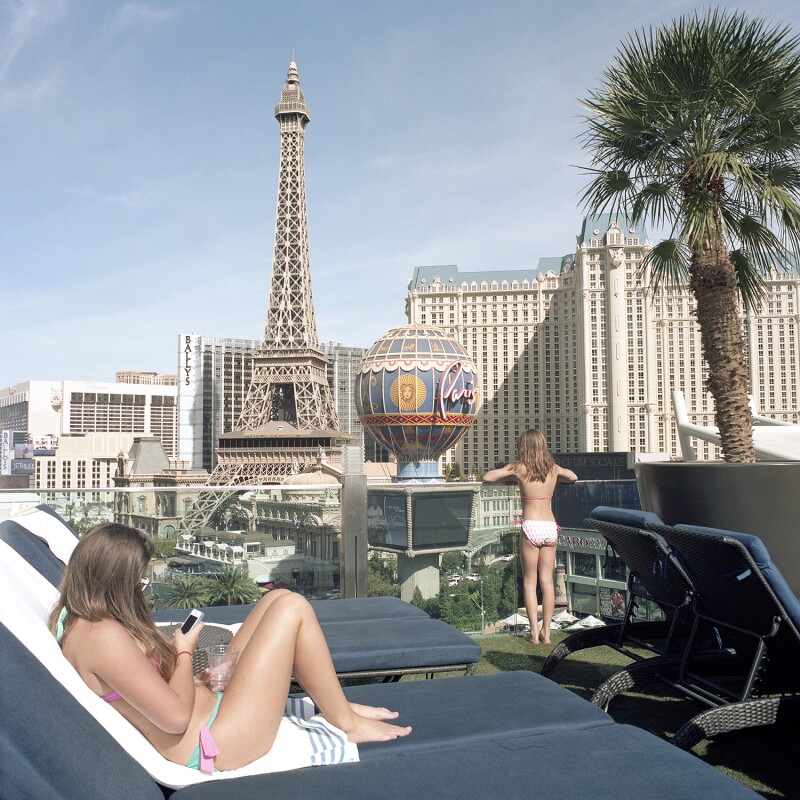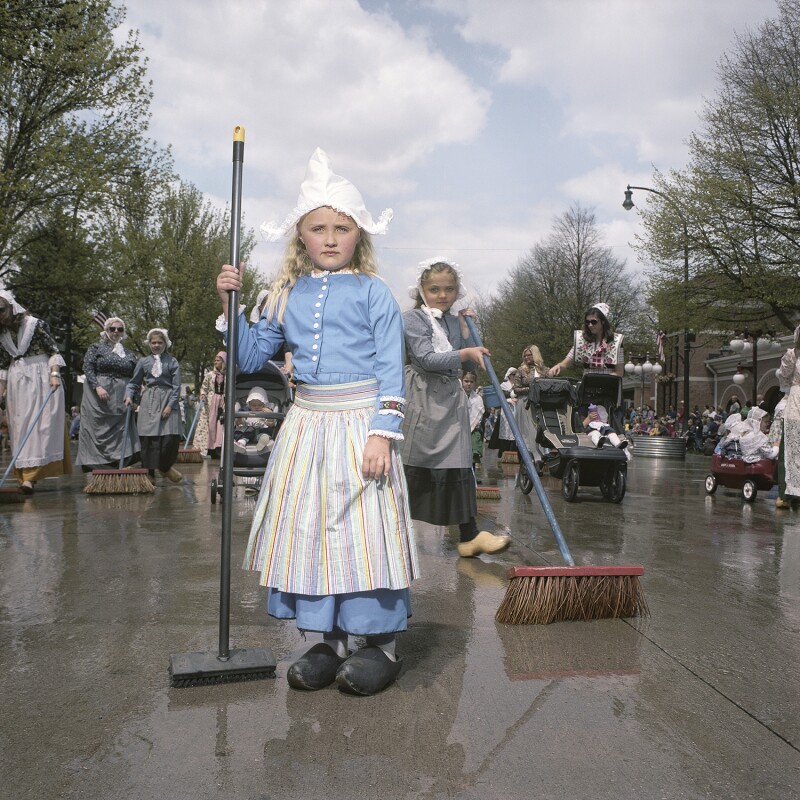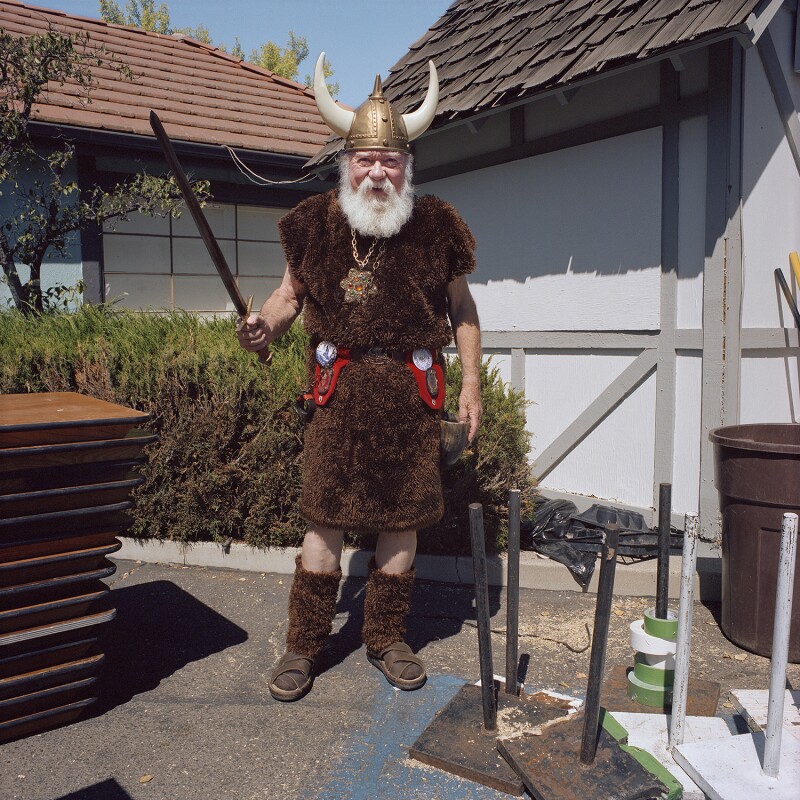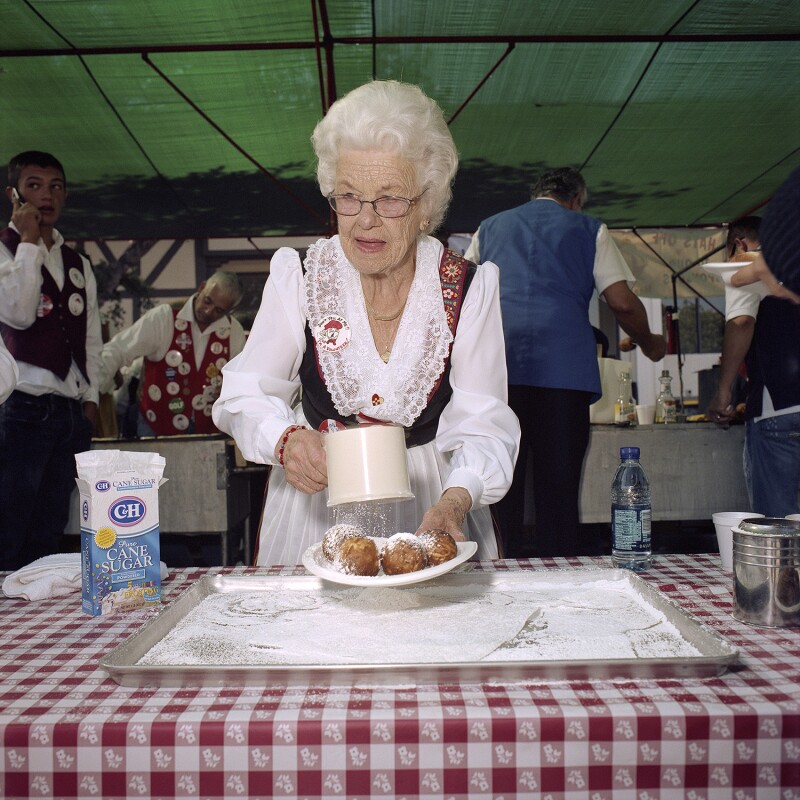There’s something a little strange about the photos in Naomi Harris’s book, EUSA.
You’ll recognize that the nostalgia-inducing shots feature Americans celebrating European culture and Europeans celebrating American culture—but the photos of boys in lederhosen and boys in cowboy outfits quickly start to become strange, and soon, you’ll start questioning the provenance of each photo. Sure, this young woman is wearing a dirndl and cowboy boots, but is she from the American South dressing up for Oktoberfest or is she at a German Oktoberfest showing off a little American flair?

Cosmopolitan, Las Vegas
Photo by Naomi Harris
According to Harris, that was exactly the intention. Citing an encroaching homogenization due to globalization, she focused the book on the two regions’ interest in each other. “It’s not like ‘Here’s America, here’s Europe.’ I make it very confusing, I don’t tell you where it is; it’s kind of the viewer’s job to figure out where they are,” she says. And guessing is part of the fun.

Tulip Festival, Orange City
Photo by Naomi Harris
Harris is no stranger to quirk in her work. The environmental portraitist says she seeks out the obscure sides of popular culture and captures them in a documentary style. Her past projects include a look at a Miami Beach senior citizens hotel, photographs of the world’s largest coffee pot and Canada’s oldest citizen, and publishing a photo book on the swinger lifestyle in America (and no, not swing dancing).

Tulip Festival, Orange City
Photo by Naomi Harris
In fact, it was on the last shoot for her book America Swings! that Harris stumbled on the town that would inspire EUSA On a recommendation, Harris stopped to explore the main street of Helen, Georgia, where the buildings are all done up in a Bavarian architectural style, restaurants offer schnitzel, and tourist shops sell cuckoo clocks right next to T-shirts that proudly proclaim “It’s a Southern thing y’all!”
“And it was like ‘Oh my! We’re not in Kansas anymore, Toto!’” says Harris.

Danish Days, Solvang
Photo by Naomi Harris
At that point, Harris was hooked. “I thought, ‘If this exists in Georgia, does this exist in other places in America?’” And from there, she wondered if the same thing happens on the other side of the Atlantic. Harris ended up visiting and photographing over 25 locations and events, including the Dutch Tulip Festival in Orange City, Iowa; an American Civil War re-enactment in the Czech Republic; a Maifest in Leavenworth, Washington; Native American festivals in Germany; a Norwegian festival in Petersburg, Alaska; and Wild West–themed amusement parks in the Canary Islands and Sweden.

Maifest, Leavenworth
Photo by Naomi Harris
Some of the European-themed towns in the United States could trace their roots back to founding families from Switzerland, Germany, or the Netherlands. At Orange City’s Tulip Festival, for example, parade participants dressed up in the regional costumes of their ancestors. Other cities, like Helen, were merely decked out in a vintage Bavarian theme to attract tourists and as an excuse to host an extremely long Oktoberfest. (Helen is home to a three-month-long Oktoberfest that begins in August every year.)

High Chaparral, Hillerstorp
Photo by Naomi Harris
Across the pond, although there are no American-themed towns, the celebration of everything American is strong during weekend-long historical re-enactments and at theme parks, and authenticity is the name of the game. For the first shoot of the project, Harris went to a Wild West weekend in Sweden. “There were all sorts of people dressed as cowboys and Native Americans and fur trappers and Civil War soldiers—both Union and Confederate—and they typically had made their costumes by hand. Even the tents that they camped in would be authentic canvas tents instead of Gortex or whatever.”

Danish Days, Solvang
Photo by Naomi Harris
And yes, it all really is as bizarre as it seems. The experiences on both sides of the Atlantic feel a bit make-believe. While each is a celebration of another’s culture and heritage, it’s a mythologized version of it. The actual history is somewhat glossed over. “You’ll go to these different events and you’ll have people dressed up . . . in hoop skirts and such and they’ll have Confederate flags up as decoration,” says Harris, implying that there’s a lack of understanding about the tension that remains around Civil War symbols. She says you’ll also find people who obsessively revere Native American culture, but who also don’t know anything about, say, residential schools. On the flip side of the coin, you won’t find a plethora of stein-wielding Americans in European-themed towns discussing the implications of World War II. On both sides, it’s an obsession with a simpler past that never really existed.

De Zwaan, Holland
Photo by Naomi Harris
As a Canadian who has lived in the United States for about 20 years, Harris is well-positioned to examine this transatlantic exchange. “I have an innate fascination for the other,” she says. A lot of her work deals with cross-cultural exchange, like her first book, California Dreaming, which is a collection of her photos and interviews by Yann Perreau about immigrants in Los Angeles, or her ongoing project “Oh Canada,” a multi-faceted portrait of her homeland.

Cowboyland, Voghera
Photo by Naomi Harris
And Harris herself is looking for new cultural experiences. “I’m not quite ready to go back to Canada full time and I think my time in the U.S. has come to a close,” she says, “so I’m thinking maybe I’ll try my luck with Europe for a little bit and try to photograph things over there as I’ll have fresh eyes.”

Tulip Festival, Orange City
Photo by Naomi Harris
One thing is for certain; she probably won’t be going back to Helen, Georgia, anytime soon. “I got stopped for rolling through a stop sign and they gave me a ticket. I mailed the check, but it came like two days late so then they charged me interest, which I didn’t pay. So now there’s probably a warrant out for my arrest,” she joked.

Tulip Festival, Orange City
Photo by Naomi Harris
EUSA features 134 of these wonderful, quirky portraits and was designed by award-winning Dutch designer Teun van der Heijden. It was published by Kehrer Verlag and first released at Paris Photo in mid-November of 2017. It is available to order on Kehrer Verlag’s website or on Amazon. >>Next: Go Inside the Quirky “Micronation” of Molossia Through These Brilliant Photos











